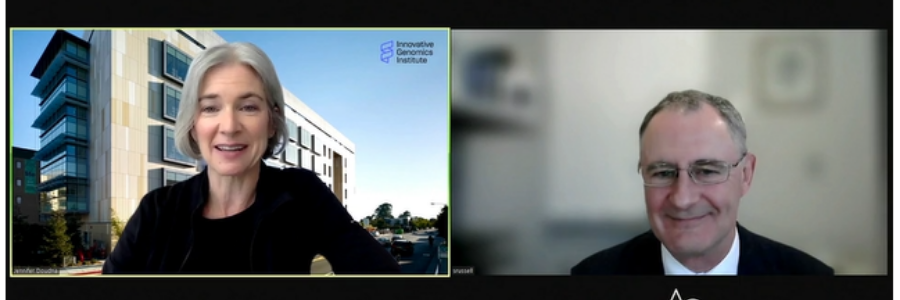There Has Never Been a Better Time to Get into Gene Editing, Doudna Says
Edith Pfister, Ph.D. - May 18, 2021
In a fireside chat on the first day of the 24th Annual Meeting, Jennifer Doudna said the field needs energetic, passionate people to bring ingenuity.

One of the highlights of the ASGCT Annual Meeting for me was the conversation between Stephen Russell, M.D., Ph.D., and Jennifer Doudna, Ph.D. (if you missed it, it’s available on the ASGCT website for free).
The conversation started with a little bit of background on CRISPR and what initially attracted Doudna to the system. She explained that it was initially just curiosity and the desire to understand how this bacterial adaptive immune system works that drove the research. Forty percent of sequenced bacteria and ninety percent of archaea have this CRISPR/Cas system, yet it is not found in eukaryotes. Perhaps, Doudna explained, this is because for an RNA-guided system like CRISPR, the host organism must be rapidly dividing, like the phages themselves. CRISPR systems are highly divergent, suggesting that they are evolving quickly. Recently, it has been discovered that some phages themselves encode Cas proteins. Why? What are the phages using them for, Russell asked. Indeed, Jillian Banfield has recently discovered larges phages that carry the CRISPR system. There is some evidence that they are involved in “phage wars,” that they use these systems to outcompete other phages. There is also evidence that they can be used to target host genes and influence gene regulatory pathways.
The conversation moved on to the Nobel Prize. What was it like doing those key experiments? It was an intense time, Doudna explained. There were things going on in her personal life as well and she realized that these experiments were going to change everything. She had to ask herself at the time what the most important things were for her to be doing. How would she take this discovery and build on it to solve real-world problems? This was when she started the Innovative Genomics Institute. Being at UC Berkeley without a medical school, Doudna realized that she needed a partner who could work on applications of CRISPR. She needed to find ways to make the technology more affordable and more accessible for people who needed it. Now the institute has an IND and will be starting a clinical trial for sickle cell disease.
Russell returned to the science and application of CRISPR. What are the most exciting things and challenges for ex vivo editing? Progress in ex vivo gene editing is going extraordinarily fast, Doudna answered. Less than 10 years from the initial work, and we’re already seeing patients effectively cured of sickle cell disease. Doudna’s excitement was palpable. Of course, the requirement for bone marrow transplantation is one of the cost and access issues that she’s interested in. The challenge is to expand the use of these technologies to make it easier, cheaper, and better for patients; how do we develop delivery strategies that don’t require the ex vivo step? Delivery came up again when Doudna and Russell discussed in vivo gene editing. There are exciting developments in both viral and non-viral modes of delivery that involve ways to minimize the active time of the complex, variant proteins with higher accuracy. Interesting targets for in vivo gene editing are skeletal muscle for muscular delivery and potentially the brain. Delivery to the brain is difficult, but there are opportunities with viruses targeting neurons and with direct injection across the blood brain barrier.
As for what Doudna is working on now, she listed collaborations with Jillian Banfield to do bacterial sequence mining and discovery, delivery, and applications in microbes, with the potential to edit whole communities in the microbiome, as some of her current projects. She credited extraordinary colleagues and her support team for allowing her to wear many hats, to work with academia and industry and beyond. She is driven by curiosity, interest, and an overwhelming desire to answer the questions, “Where is this going? How do we make sure this is used effectively to help people and not cause harm?”
If you look at the history of technology, important technologies have always come about as a result of curiosity driven science. The question then is how do you marry curiosity with an effective pipeline for translation? You need both curiosity driven science, applied science, and the more entrepreneurial spirit to work together. For Ph.D. students, postdocs, and new investigators, she says, “there has never been a better time.” Find good mentors and colleagues who will push you.
Dr. Pfister is assistant professor at the University of Massachusetts Medical School and chair of the ASGCT Communications Committee.
Related Articles